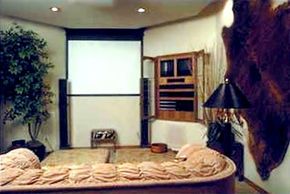Putting It All Together
Once you have all the components, it's time to set up the theater space. There are several factors to keep in mind when choosing and arranging the home theater room.
First of all, consider the architecture of the room. A home theater should be something like a movie theater -- you want an enclosed, rectangular room, with a good amount of space and not too much outside light. You need an enclosed space to get the best sound quality -- open rooms don't have ideal acoustics. If you are building a top-of-the-line theater, you may want curtained walls. This soft surface cuts down on disruptive echoes. For the same reason, it is generally better to have a carpeted floor than a wood or linoleum floor.
Advertisement
Once you've decided what room to use, you need to figure out where to put everything. To find the best position for the television, just use common sense. It should be easily visible -- you don't want to crane your neck -- and it shouldn't be in a place that gets a lot of glare from outside. Put the television wherever it seems most logical, and build your system around that.
Getting the sound system in place is a bit more complicated. You should set the three front speakers up so that they are spaced evenly, all at about the same height. Also, make sure they are near the level of the television screen so that the sound seems to be coming from the action and actors you're watching on the TV. The idea is that you shouldn't be made aware of the speakers when you watch a movie -- your attention should be on the movie.
You have a couple of different options for arranging the rear speakers. Dolby Digital is designed for speakers positioned to either side of the listener, while Dolby Pro Logic systems should have the rear speakers behind the listener. In any case, the rear speakers should be mounted at the same height, spaced an equal distance from the listener. Of course, chances are you'll have more than one listener, so the spacing won't be equal for everybody. You can find the central listening position -- such as the middle of the couch -- and space everything according to that point, while still paying attention to other seats in the room.
It doesn't matter so much where you put your subwoofer. The low frequencies aren't directional like the higher frequencies emitted by the main speakers, so it can really go anywhere in the room. For the best rumbling effect, however, you should put the subwoofer on the floor or against a wall -- this will help the low frequencies carry through the room.
Once your television and speakers are in place, you'll need to calibrate them. Your television set may have a specific setup process for adjusting the color and brightness. Otherwise, you can use the THX optimizer found on many DVDs to perform your calibrations. You can also calibrate each speaker using a sound-pressure level meter. This will make sure that your speakers produce identical levels of volume.
Another thing to consider in your home theater is lighting. It's important that you don't have a lot of bright ambient light in the room, because this may cause glare on the screen or distract from the movie. But you also don't want a completely dark room, because the high contrast of the light from the screen may strain your eyes.
Ideally, a home theater should have soft ambient lighting connected to a dimmer. For the full theater experience, you can get an automatic dimmer and hook it up to the audio/video receiver. When you start up the movie, the lights will go down to a preset level on their own. Or you can control the lights with a remote control. Home theater systems can also be configured with curtains or cabinet doors operated by remote control. (Check out this site for more information on home-theater remote controls.)
As we've seen, the best home theater setup completely depends on your budget and your needs. If you just want a better entertainment system in the family room, a basic "home-theater-in-a-box" set, a DVD player and a good-sized television will be more than satisfactory. But if you want your own movie theater, with a huge screen and fantastic acoustics, you'll probably need to bring in a home theater expert and a contractor. The most important thing is to try everything out ahead of time to make sure your movies will look and sound great.
For lots more information on home theaters, including reviews of specific components, check out the links below.
Related HowStuffWorks Articles
- 10 Hot Home Theater Systems
- How Televisions Work
- How Cable Television Works
- How DVRs Work
- How VCRs Work
- How DVD Players Work
- How Blu-Ray Works
- How Speakers Work
- How Movie Sound Works
- How Digital Television Works
- How Satellite TV Works
- How Projection Television Works
- How HDTV Works
- How Plasma Displays Work
- How LCD Works
- How LCoS Works
- How DLP Sets Work
- How Video Formatting Works
- How Movie Screens Work
- How Movie Projectors Work
- Where is the best place to sit when I go to the movies?
- On television, how does close-captioning work?
- What does the V-chip really do and how does it work?
